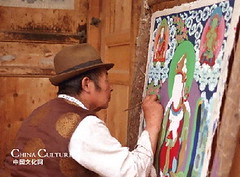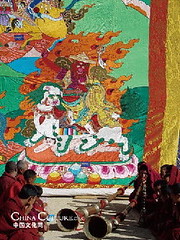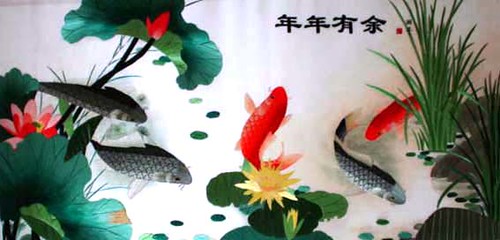| Home > Living in China > Art |
Tangka Art----Treasure of Tibet
 |
Clusters of white clouds drifting across the blue sky, paths winding through snowy mountains, and Buddhist temples looming in infused incense--these are the images most people have of Tibet, the land of eternal mystery. And when it comes to the art treasures of the region, no image is more intrinsically associated with Tibet than the iconic Tangkas.
"Thangka," also known as "Tangka", "Thanka" or "Tanka", is a painted or embroidered Buddhist banner which was hung in a monastery or a family altar and occasionally carried by monks in ceremonial processions. In Tibetan, the word “thang?means flat, and thus the Thangka is a kind of painting done on flat surface but which can be rolled up when not required for display, sometimes called a scroll-painting.
Originating from the principal artistic schools of Western India (7th and 8th centuries), from which Tibetan painting takes its cue, thangka consists of a picture panel which is painted or embroidered, a textile mounting; and one or more of the following: a silk cover, leather corners, wooden dowels at the top and bottom and metal or wooden decorative knobs on the bottom dowel.
 |
The pictorial subjects of thangkas include portraits of Buddha’s, stories from the lives of saints and great masters. Thangkas are usually rectangular in shape, and the square ones are reserved for Mandalay. Thangka paintings vary in size, ranging from a little over a few square centimeters to several square meters.
Every part of Thangkas?making process is done by hand. Sometimes the artist will spend three hours painting a small flower. A large thangka often takes large team of artists months, even years, to make. The material used for thangkas is linen cloth or cotton fabric; silk cloth is reserved for important subjects. Before painting begins, the material is stitched along the edges with flax thread and stretched on a specially made wooden frame. Then a paste made of animal glue mixed with talcum powder is spread over its surface to block up the holes in it. When the paste is scraped off and the cloth gets thoroughly dried, the material is ready for painting. To begin, the artist works out the sketches of the images with charcoal sticks. The drawing usually begins with the figure in the centre and then goes to the surrounding deities or landscape then coloring comes last.
The pigments used come from non-transparent minerals and plants such as malachite and cinnabar. They are mixed with animal glue and ox bile to make the luster stay. When the painting is done, it is mounted on a brocaded silk border. Important thangkas are embroidered on transferred outlines; some of them use a great variety of stitch patterns such as flat and piled stitches to give them a three-dimensional effect.
Intent & in Tents
As mysterious as Shangri-la, thangkas fascinate people from all over the world. However, what is the purpose of a thangka, what use was it originally intended for?
 |
Firstly, a thangka painting is not simply a decoration or a creation of beauty, but a religious object and a medium for expressing Buddhist ideals. These works of art function as models on which the practitioner can reflect and meditate. By meditating on such objects, one can train the mind and gain an understanding of certain types of awareness that specific image portrays. Other reasons for commissioning a thangka painting may be to bring about good health, prosperity or long life.
Secondly, does the concept of artistic intent apply to thangkas? Only rarely do thangkas express the personal vision or creativity of the painter, and for that reason thangka painters have generally remained anonymous as have the tailors who made their mountings. There is a vast amount of iconographic information provided in thangkas, some of it literally spelled out. If being watched closely, many thangkas spell identification of figures and scenes in formal and delicately rendered scripts.
Thangkas were important articles of the tent culture of nomadic monastic groups in medieval Tibet. Nomadism was good for the people but intensely harmful for the thangkas. Rolling and unrolling was, and still is, unavoidably damaging for thangkas.
Mountings
Thangkas are not only paintings. Their textile mountings are very important. When dealing with the mountings, a new set of questions arises. Did the artist of the painting have any control over the style and proportions of the mountings which surround the painting? Is the silk brocade mounting currently part of this thangka in fact the original mounting for this picture panel, or could it be the third or fourth replacement? The answer to the latter question can often be found on the edges of the support where several rows of stitch holes can indicate that the mounting has been changed.
Does the mounting obscure significant sections of the painting? Tailors have been known to sew mountings with a window so small that it covers important iconographic and aesthetically relevant sections of the painting composition. The form of the mounting therefore may alter the artist's intent by obscuring details significant to the iconography and aesthetics of the painting.
Popularity & Value
For many years, Tangkas were not known to the Western world. But with the modernization of Tibet, the paintings have been turning up with increased frequency in local and international art collection markets.
At a sale of Christie's Auction House in New York in 1994, a large embroidered Tangka painted at the time of the Ming Dynasty (1368-1644) was sold for $1 million. In 2002, the same Tangka was sold again at Christie's Hong Kong for around $3.6 million, making it a record for any auctioned Tangka. However, nowadays it is rare to find Tangkas painted before the Ming Dynasty.
Apart from ancient classic works, created in Tang (618-907) and Qing (1644-1911) dynasties, modern Tangka paintings have also been favored by enthusiasts and collectors both domestically and overseas. Some works of contemporary artists have great value for collectors because of the painters' consummate skill and innovation of blending modern painting styles or approaches with traditional characteristics.
With the development of a new generation of Tangka artists, the content of Tangka artworks has been enriched. Bodhisattvas are no longer the only theme. In recent Tangka paintings, there are various images of contemporary life, such as trains traveling through Tibet, coca-cola tins and even lamas holding telescopes.
Art
 more
moreThe Romance of butterfly lovers

Introduction to Suzhou Embroidery
Suzhou embroidery-one of China's four famous embrodiery styles, has a

Local Styles of Paper-cuts in China
Daisy Though making of paper-cut is simple, its

Customs
 more
more



 print
print  email
email  Favorite
Favorite  Transtlate
Transtlate 
